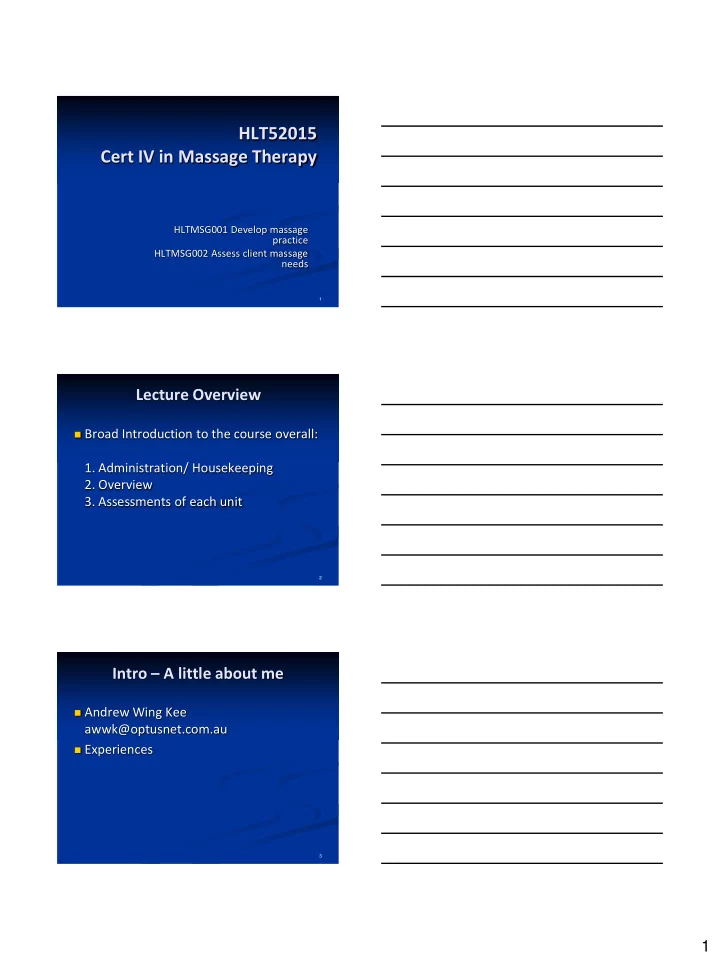

HLT52015 Cert IV in Massage Therapy HLTMSG001 Develop massage practice HLTMSG002 Assess client massage needs 1 Lecture Overview Broad Introduction to the course overall: 1. Administration/ Housekeeping 2. Overview 3. Assessments of each unit 2 Intro – A little about me Andrew Wing Kee awwk@optusnet.com.au Experiences 3 1
Housekeeping Class times: 3 hour class 0900-1200. 15 min break Hygiene & maintenance Equipment and resources required 4 Activity 1 Interviewing skills is a vital skill for this specialty. Interview the person next to you. Ask the person next to you three questions about themselves. Present your partner’s responses to the class. 5 Week 1 Introduction to Massage therapy Saturday 20 February 2016 09:00-12:00 6 2
The central philosophies of Massage practice HOLISM- as the belief that all parts of the body work • together to allow the body to work as a whole Used determine a client’s health status • Presenting symptom 1. Lifestyle factors 2. Personal/family health history 3. Condition of other bodily systems 4. This will help assess the clients needs and identify the best treatment. The Massage system of treatment is a systemic approach- Assessment > Treatment plan > specific techniques for each issue 7 Massage therapy in the broader health care system The practice of massage therapy is the systematic assessment and treatment of the muscles, tendons, ligaments and connective tissues of the body to: Maintain, rehabilitate or augment physical function Relieve pain Prevent dysfunction Enhance health and promote wellness 8 Massage therapy includes the use of: Systematic external application of a variety of manual techniques including stroking, friction, vibration, kneading, compression, percussion, stretching and passive joint mobilisation Exercise prescription External application of Heat, Cold, Topical preparations, Strapping tape & Mechanical devices * The application of these techniques is based on current scientific understanding and evidence informed practice. 9 3
Massage therapy does not include: High velocity-low amplitude (HLVA) manipulations Prescription or recommendation of supplements or other ingestible substances Counselling (unless the massage therapist holds a recognised counselling qualification) Diagnosis of conditions or diseases. 10 Types of Massage Swedish massage Reflexology Chinese Massage Thai Massage Deep tissue Massage Sports/ Remedial Massage Integrative Methods Aromatherapy 11 Therapeutic benefits of Massage Increases circulation Enhances the immune system ( >Lymphocytes) Promotes nervous system functioning Reduces blood pressure Relieves pain, muscle tension & inflammation (CV disease, joint px, depression, asthma etc.(<cytokines) Improves mood, intellectual reasoning and job performance Positive effect on conditions such as fibromyalgia, arthritis, diabetes and migraine headaches 12 4
Specific benefits of massage Stimulate the nervous system to help reduce muscle atrophy Increase muscle tone Stimulate the functions of the skin or an organ deep inside the body Sedate the nervous system to help ease muscle tension, spasticity, stress-related symptoms and headaches Boost the functioning of the immune system and maintains health when done regularly Stimulate sluggish circulation or slow down the circulation post activity Allow better range of motion and support the connective tissue and muscles 13 Representative bodies for Massage Therapy Provide assistance to members Maintain a register of qualified practitioners Respond to enquiries/complaints from the public Ensure members maintain high standards of ethical & professional practice Allow members access to insurance and health funds AAMT ( Australian Association of Massage Therapists) AMT (Association of Massage Therapists) MAA (Massage Association of Australia) ANTA (Australian Natural Therapies Association) ATMS (Australian Traditional Medicine Society) 14 Hygiene & Maintenance Hand washing Skin care & finger nails Cleaning of towels Oils and balms 15 5
Homework & preparation for Lesson 2 Lesson 2: Read Basic Anatomy for Massage 16 6
Recommend
More recommend